Student Research
Our students take on research projects with faculty here at Gordon College as well as during summer research experiences around the US and abroad. All students discuss their results in lectures given on our campus; some students also bring the results of their research to an American Chemical Society national meeting. Here are a few selected examples of research projects that students have engaged in during the past year or two:
- HanByul Chang '15 – on campus research toward Honors Thesis
Undergraduate laboratory experience on kinetics: Using the FeIII-TAML system with common food dyes - Mollie Enright '15 – summer research at Michigan State University
Further defining acylsugar structural diversity within Petunia axillaris - HanByul Chang '15 – summer research at University of Ulm, Germany
Electrochemical Stability of Ru(0001) and Pt Modified Surfaces - Justin Andrews '14 – summer research at Texas A&M University
A Novel Procedure for the Removal of Ru after ROMP using PIB-bound Isocyanides - Ben Stewart '13 – on campus research toward Honors Thesis
A Green Chemistry Approach to Fabricating Porous TiO2-Acrylic Composite Photocatalytic Materials - CJ Daly '13 – summer research at Georgia Tech
Plasmonic Enhancement of Solar Energy Conversion - Lee Andrews '13 – on campus research toward Honors Thesis
The Relative Efficacy of Platinized and non-Platininzed Nanoparticles Deposited in a Porous Polymer Wafer Reactor for the Photocatalytic Oxidation of Carbon Monoxide - Bria Pelletier '13 – on campus research toward Honors Thesis
The Determination of the Optimal Crosslink Density for the Durability of Acrylic-Titania Composite Photocatalytic Materials - Ruth Chadwick '13 – summer research at Purdue University
Mapping Irradiance in a Compound Parabolic Collector - Rachael Albury '13 – on campus research toward Honors Thesis
Greener Dehydration Chemistry: Clay Catalyzed Dehydration of Alcohols for the Undergraduate Laboratory
Student participation at American Chemical Society National Meetings
Some students bring the results of their undergraduate research to the primary professional conference for chemistry—the American Chemical Society national meeting. During the past decade, many of our students have made these journeys an important part of their professional development.
ACS Undergraduate Student Presentations
Poster presentations unless stated to be Oral. Presenting authors listed. (Non-presenting co-authors are parenthesized.)
2017/2018 (New Orleans, LA)
- Victoria Arau (Yiliyasi Wusimanjiang, Shanlin Pan)
Electrochemical and electrogenerated chemiluminescence study of organolead halide perovskite nanocrystals - Anne-Milda Pu
Computational studies of the O2 binding energy and activation energy of O2 dissociation over M13@Pt42 nanoparticle catalysts - Julia R. Bonney
Greener Friedel-Crafts acylation using a deep eutectic solvent: An undergraduate laboratory method - Kayla Kroning
Using FRET to elucidate the lipid trafficking mechanism of SP-B C and N terminal peptides in comparison with KL4 - Quincy Dougherty (Oral presenter) (Lian Atlas, Victoria Ganss, Anna H. Kjellson, Sara Lareau)
(gc)2: Gordon College’s commitment to green chemistry - Lian Atlas (Quincy Dougherty, Victoria Ganss, Anna H. Kjellson, Sara Lareau)
On the road again: Developing our chapter through service, locally and beyond
2016/2017 (San Francisco, CA)
- Kayla Kroning
Use of membrane fusion to understand the role of lung surfactant protein B in lipid trafficking - Danel Gray
Computational studies of oxygen bond lengthening with group-10 metal clusters - Mirielle Nauman
Green microwave nitration as an undergraduate organic chemistry lab procedure - Logan Walsh
Towards green multistep synthesis in the Organic Chemistry laboratory curriculum: Conversion of alcohols to ketones via conventional heating - Verna Curfman (Oral presenter)
Recipe for success: How outreach has impacted Gordon College's ACS student chapter - Verna Curfman and Ivy Ngo (Oral presenters)
How student chapters can have impact on green chemistry and social justice education - Ivy Ngo (Verna Curfman, Logan Walsh, Katie Elliott, Eimi Percival)
Igniting change: Gordon College's ACS chapter's influence on campus and the community
2015/2016 (San Diego, CA)
- Ian Commins (Elizabeth Fjellstad, Luke O'Donnell, Andrew Swartzel)
Markovnikov hydration of alkenes using greener alternative reagents - Elizabeth Fjellstad (Ian Commins, Luke O'Donnell, Andrew Swartzel)
Greener procedure for the regioselective hydration of alkenes: Use in the undergraduate organic laboratory - Verna Curfman (Daruenie Andujar)
Fermentation of yeast cells as a greener and effective method to produce starting materials in the Hantzsch reaction - Daruenie Andujar (Verna Curfman)
Green Hantzsch reactions suitable for the teaching laboratory - Daniel Gray
Computational studies of oxygen bond weakening with group-10 metal clusters - Harrison Miller
Preparation of 6-nitro-2,3-diphenylquinoxaline: Green multistep organic synthesis - Julia Bilancieri, Abigail Lutz, and Sarah Zuidema
Microwave-assisted direct amidation: A green chemistry laboratory preparation - Logan Walsh and Courtney Olbrich
Genetic diversity of the newly invasive species Colpomenia peregrine along the coast of Massachusetts - Mirielle Nauman (Daruenie Andujar, Verna Curfman, Elizabeth Fjellstad, Daniel Gray, Logan T. Walsh)
Catalysts: Changing reactions through professionalism, community, and outreach
2014/2015 (Denver, CO)
- HanByul Chang
Undergraduate laboratory experience on kinetics: Using the FeIII-TAML system with common food dyes - Mollie Enright
Green extraction of lycopene from tomato (Lycopersicon esculentum) using 2-methyltetrahydrofuran
Further defining acylsugar structural diversity within Petunia axillaris - Stacy Strobel and David Parr
Direct amidation of carboxylic acids via microwave-assisted synthesis: Greener organic laboratory options - Daniel Gray (Brittany J. Marshall, Logan T. Walsh, Elizabeth Fjellstad, Daruenie Andujar, Mollie C. Enright)
The Science of Service: Gordon College’s Student Chapter of the American Chemical Society
2013/2014 (Dallas, TX)
- Justin Andrews
Novel procedure for the removal of Ru after ROMP and RCM reactions using PIB-bound isocyanides - Mollie Enright
Effect of high tunnels use on lycopene content in 'Brandywine' and 'Jet Star' tomatoes (Lycopersicon esculentum Mill.) - Brittany Marshall
Greener synthetic methods for the undergraduate laboratory curriculum: Microwave-assisted catalytic oxidation of alcohols - Stacy Strobel
Microwave synthesis in the undergraduate organic chemistry laboratory: Greener synthesis of amines - Sarah McCarron (Sarah Goss, Maria Cunningham)
Second graders model the effects of pollution on a small plant system - Logan Walsh (Justin Andrews, Owen Williams, HanByul Chang, Sarah McCarron, Ruth Chadwick, Elizabeth Fjellstad, Rachel Olugbemi, Daniel Dufoe)
Passing the torch: A second generation of leadership at Gordon College
2012/2013 (New Orleans, LA)
- Rachael Albury and Justin Andrews
Greener dehydration chemistry: Montmorillonite clay-catalyzed dehydration of alcohols - Lee Andrews
Porous TiO2/acrylic composite materials for the photocatalytic oxidation of carbon monoxide - HanByul Chang
Undergraduate kinetics laboratory experiment: The catalytic degradation of common food dyes using the FeIII-TAML system; - Clyde Daly (Lee Andrews, Bria Pelletier and Benjamin Stewart)
Investigation of porous polymeric support materials for TiO2 photocatalytic water purification - Bria Pelletier (Clyde Daly and Benjamin Stewart)
Determination of the optimal crosslink density for the durability of acrylic-titania composite photocatalytic materials - Benjamin Stewart (Clyde Daly and Bria Pelletier)
Green chemistry approach to fabricating porous TiO2-acrylic composite photocatalytic materials - Owen Williams
Photocatalytic degradation of triclosan - Sarah McCarron (Stacy Strobel, Elaine Hong, Ruth Chadwick, Mollie Enright, Benjamin Stewart, Bria Pelletier and HanByul Chang)
Gordon College Student Chapter of the ACS: Making connections
2011/2012 (San Diego, CA)
- Clyde Daly (Bria Pelletier and Benjamin Stewart)
Graphite furnace atomic absorption spectroscopy for the detection of TiO2-Ti removed from the surfaces of acrylic-titania composite photocatalytic materials - Bria Pelletier (Clyde Daly and Benjamin Stewart)
Effect of crosslink density on the durability of acrylic-titania composite photocatalytic support materials - Benjamin Stewart (Clyde Daly and Bria Pelletier)
Effect of porosity on the photocatalytic activity of acrylic-titania composite photocatalytic materials - Ariel Guiguizian
Optimizing the use of the FeIII-TAML system for a methyl-amine to ketone conversion - Kristen Entwistle
Structural determination of a phenolic polymer produced using the FeIII-TAML system - Rachael Albury (with Salem State University collaborators)
Green chemistry in the laboratory curriculum: Alkene synthesis by dehydration of alcohols in the presence of Montmorillonite clay - Justin Andrews (Kristen Entwistle, Ariel Guiguizian, and Benjamin Stewart)
Reawakening the student chapter at Gordon College: A project accomplished!
2010/2011 (San Francisco, CA and Boston, MA)
- Grant Eilers (Cory Strnad)
Partnerships between chemistry departments and the community: Green chemistry activities for homeschooled high school students - Andrew Worth
Conversion of secondary aliphatic amine moiety to ketone by FeIII-TAML system - Kim McCabe and Jess Doiron
Ambassadors for Green Chemistry networking project
2009/2010 (Washington, DC)
- Rachel Shirron
First principles investigation of ruthenium metal complexes used as catalysts in water oxidation - Rowan Walker (Keti Gitit Assor)
Greener oxidation options: Molybdate-catalyzed synthesis of conjugated aldehydes and ketones
2008/2009 (Salt Lake City, UT)
- Erin Thames and Rowan Walker
Selective oxidation of benzyl alcohol to benzaldehyde: A green chemistry laboratory experiment - Suzanne Poole
Determining the efficacy of popular antioxidants through the fluorescence of diphenyl-1-pyrenylphosphine (DPPP): An analytical laboratory experience - Ryan Cappa and Gina Gioranino (Kevin Quackenbush, Leonard Stevenson and Trevor Wright)
BGB-20 ecoSoap: Utilizing biodiesel glycerin by-product in the large scale preparation of soap to illustrate the principles of green chemistry
2007/2008 (New Orleans, LA)
- Soo Yeon Kwon (Matthew Levy, Daniel Sargent, and Marissa Weaver)
Measuring ecotoxicity: Green chemistry experiment for the undergraduate laboratory curriculum - Rebecca Havens and Jennifer Soerensen (Matthew Austin)
Okra seed oil biodiesel: Investigating underutilized seed oils as potential biofuels
2006/2007 (Boston, MA)
- Angela Langlais and Amanda Wagers (Oral presentation)
Green chemistry curriculum development to empower outreach to middle- and high-school students and teachers - Laura Hasiuk and Erica Wetter (Sarah Massanari and Marissa Weaver)
Comparative ecotoxicity of petroleum diesel, biodiesel from waste fryer oil and biodiesel from unused fryer oil - Andrew Luhrs
Introducing ecotoxicity to the chemistry laboratory curriculum: Studying green chemistry principles by measuring ecotoxicity using Escherichi coli
2005/2006 (Atlanta, GA)
- Eric Mehlberg
Daphnia ecotoxicology: An interdisciplinary green chemistry laboratory exercise for concurrent organic chemistry and animal physiology courses - Andrew Luhrs, John Stoeckle (Dustin Hendrickson, Aaron Schiffer)
Green Chemistry Metrics Calculator (GCMC): A JavaScript application for green chemistry education - Matthew Austin and Kathryn Laporte
Synthesis and photochromism of 6-nitrospiropyran: A green chemistry preparation for organic chemistry laboratory - Erica Wetter
Multicomponent zeolite-catalyzed synthesis of β-acetamido ketones: A green chemistry laboratory experience.
2004/2005 (San Diego, CA & Washington, DC)
- Andrew Luhrs
Expansion of Topological Index Calculator: Incorporation of the Schultz Index - Laura Hamel (Oral presentation)
Analyzing green chemistry: A description of metrics with applications in academia and industry - Steven Granz
Topological Index Calculator III: Computation of the Hosoya Index using SMILES representation
Best Poster Award
Chemistry and Biology double major Kristen Entwistle won top honors at the 2011 Undergraduate Research Symposium held here at Gordon. Her work was recognized as the best poster in the physical sciences area. Andrew Worth, also a chemistry major, was awarded as runner-up.
- Structural Determination of a Synthetic Polymer by Gaussian Computational Modeling Software and Nuclear Magnetic Resonance Spectroscopy
Note: Andrew is in graduate school at the University of Pennsylvania in pharmacology and Kristen is attending graduate school at Michigan State University in pharmacology
URS-2011 Winner (PDF)
Boston
At a recent ACS National meeting, students traveled all the way to Boston to present on their research.
The following posters were presented:
- Phenolic Polymerization using FeIII–TAML
- Conversion of Secondary Aliphatic Amine Moiety to Ketone by FeIII—TAML System
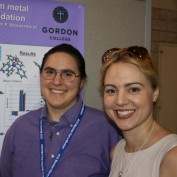
Washington DC
Gordon College students and faculty traveled to Washington, DC to present their work at an American Chemical Society National Meeting.
The following poster was presented.
- First principles investigation of ruthenium metal complexes used as catalysts in water oxidation
Note: Rachel is currently in graduate school at the University of Pittsburgh
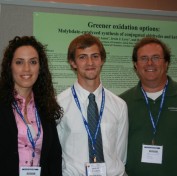
Washington DC
Gordon College students and faculty traveled to Washington, DC to present their work at an American Chemical Society National meeting.
The following poster was presented.
- Greener oxidation options: Molybdate-catalyzed synthesis of conjugated aldehydes and ketones
Note: Rowan is currently working at the Warner-Babcock Institute for Green Chemistry
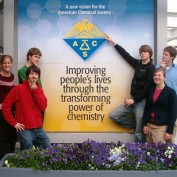
In the past decade, dozens of students have undertaken research projects that have resulted in presentations at regional and national science meetings. Students have presented at the following venues:
- Denver, CO 249th National Meeting of the American Chemical Society
- Bridgewater, MA 13th Annual Undergraduate Symposium on Sustainability and the Environment
- Dallas, TX 247th National Meeting of the American Chemical Society
- New Orleans, LA 245th National Meeting of the American Chemical Society
- San Diego, CA 243rd National Meeting of the American Chemical Society
- Wenham, MA 3rd Annual Sigma Xi Northshore Symposium
- Boston, MA 240th National Meeting of the American Chemical Society
- Beverly, MA 2nd Annual Sigma Xi Northshore Symposium
- San Francisco, CA 239th National Meeting of the American Chemical Society
- Washington, DC 238th National Meeting of the American Chemical Society
- Salt Lake City, UT 237th National Meeting of the American Chemical Society
- Bridgewater, MA 7th Annual New England Environmental Research Symposium
- New Orleans, LA 235th National Meeting of the American Chemical Society
- Bridgewater, MA 6th Annual New England Environmental Research Symposium
- Boston, MA 234th National Meeting of the American Chemical Society
- Bridgewater, MA 5th Annual New England Environmental Research Symposium
- Atlanta, GA 231th National Meeting of the American Chemical Society
- Washington, DC 230th National Meeting of the American Chemical Society
- San Diego, CA 229th National Meeting of the American Chemical Society
- Lexington, MA Educators' Veritas Forum
Best Poster Award
"The Investigation of Atomic-Level Interactions in the Cancer-causing BCR-ABL Tyrosine Kinase and Imatinib Through the Application of the ONIOM Method"
Nigel won the best poster award at Gordon College's 2009 Undergraduate Research Symposium. The poster presented his work on computational chemistry.
You can see the full poster using the link below.
Learn more about the Undergraduate Research Symposium.
Note: Nigel is currently attending medical school.
Nigel Poster May 2009 (PDF)
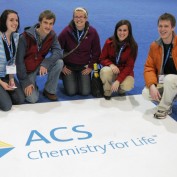
Salt Lake City
Five Gordon students traveled to Salt Lake City to present their work at the American Chemical Society (ACS) National Meeting. The following posters were presented.
- Selective oxidation of benzyl alcohol to benzaldehyde: A green chemistry laboratory experiment
- BGB-20 ecoSoap: Utilizing biodiesel glycerin by-product in the large scale preparation of soap to illustrate the principles of green chemistry
- Determining the efficacy of popular antioxidants through the fluorescence of diphenyl-1-pyrenylphosphine (DPPP): An analytical laboratory experience
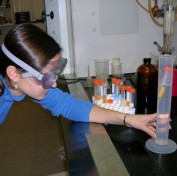
Okra Seed Oil
Okra seed abounds in tropical and sub-tropical regions, and has a protein and fat profile similar to that of conventional vegetable oils used for both food and biodiesel production. Okra seed, however, is underutilized and understudied.
Chemists all around the world are becoming more and more interested in finding "greener," more environmentally friendly, and less hazardous ways to produce chemical products.
Green Chemistry, specifically, is the design of products and processes that reduce or eliminate the use and generation of hazardous substances.
Because there has been much concern about the decreasing world supply of petroleum diesel, biodiesel looks to be a renewable and sustainable source of fuel in the future. Biodiesel also looks to be a greener alternative to petroleum diesel.
Biofuels, made from the transesterification of vegetable oils, fulfill several principles of Green Chemistry:
- Renewable feedstocks: Made primarily from crops, so supply would be constant.
- Design for degradation: Biodegradable
- Design safer chemicals: Non-toxic
- Prevent Waste: Biofuels can be prepared from many wastes, such as waste fryer oil, and also do not put additional carbon dioxide into the atmosphere.
Presented is a laboratory-scale extraction of oil from okra seed and preparation of biodiesel from okra seed oil. We have also done a comparison of the properties of okra seed biodiesel to conventional biodiesel and commented on the viability of okra seed as a potential fuel source. Finally, we discuss the outcomes of this project in light of the "12 Principles of Green Chemistry."1
1Poster Presented at the 235th American Chemical Society Meeting in New Orleans, April 2008.
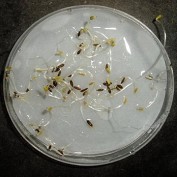
Measuring Ecotoxicity with Lettuce Seeds
The goal of green chemistry is the design of materials and processes that are inherently safer for human health and the environment. Currently, few undergraduate chemistry students are trained about the toxicity of chemicals and even fewer experience the laboratory investigation of chemical toxicity. Here we present a laboratory experiment that enables students to measure ecotoxicity of different alternative starting materials used for the preparation of biodiesel. Lettuce seed assays were used to compare the ecotoxicity of methanol, ethanol, and 2-propanol by these toxins' effects on germination rate and root elongation of lettuce seeds. The experiment is simple, fast, inexpensive, reproducible, and possible to perform with standard equipment available in most chemistry teaching laboratories.
The seeds were exposed to water dosed with alcohol (either methanol, ethanol, or isopropanol) at various concentrations to determine a dose/response effect. The seeds were allowed to grow for one week, in the dark, at room temperature. After one week, seeds were assayed by counting the number of seeds that germinated and measuring the root elongation of the germinated seeds.
The data suggests that toxicity of all three alcohols intensifies as concentration increases. Surprisingly, methanol appears to be less toxic to the seeds than the other two alcohols. Methanol is known to be more harmful than ethanol or isopropanol to humans, and thus the result reminds us that ecotoxicity and human toxicity are not necessarily
the same.1
This lab experiment has been documented in the GEMS database and also has been incorporated in the University of California/Berkeley's green chemistry Biofuel lab sequence.
1Poster Presented at the 235th American Chemical Society Meeting in New Orleans, April 2008.

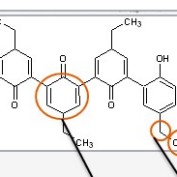
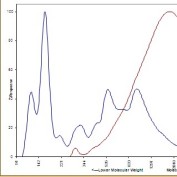
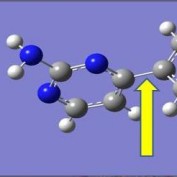
 Chemistry
Chemistry Student Research
Student Research


